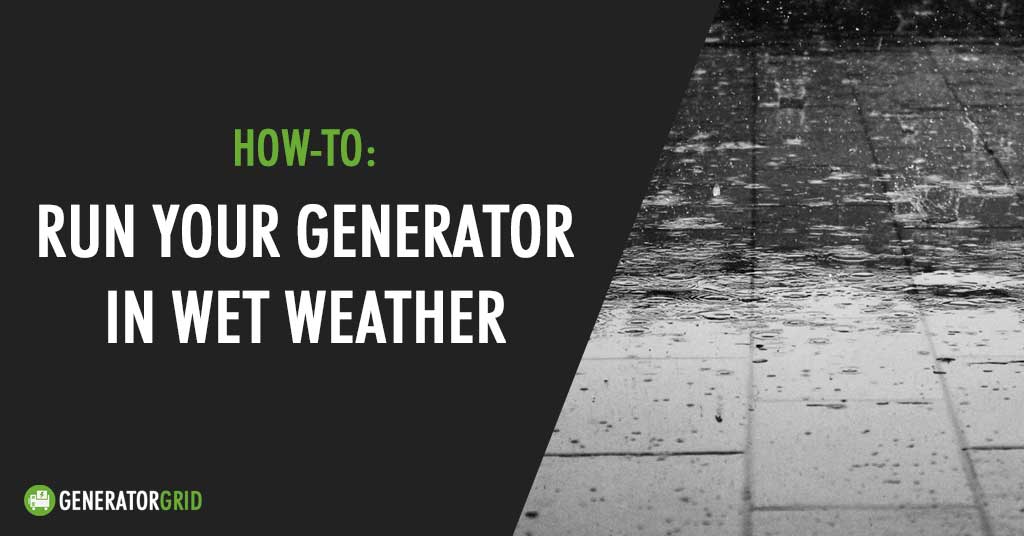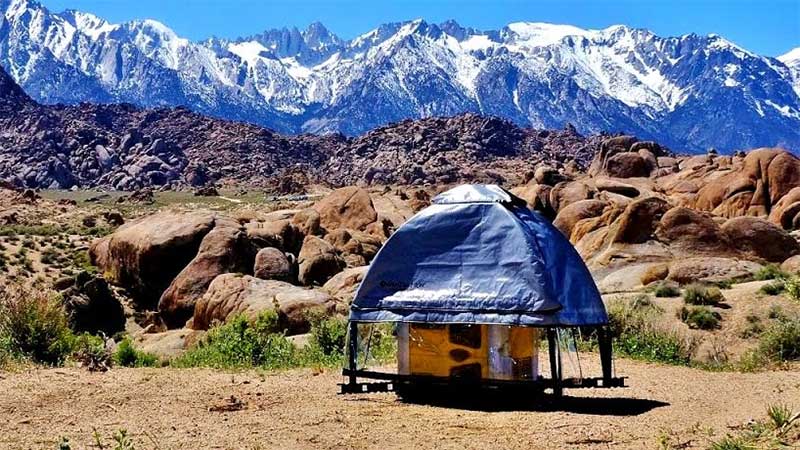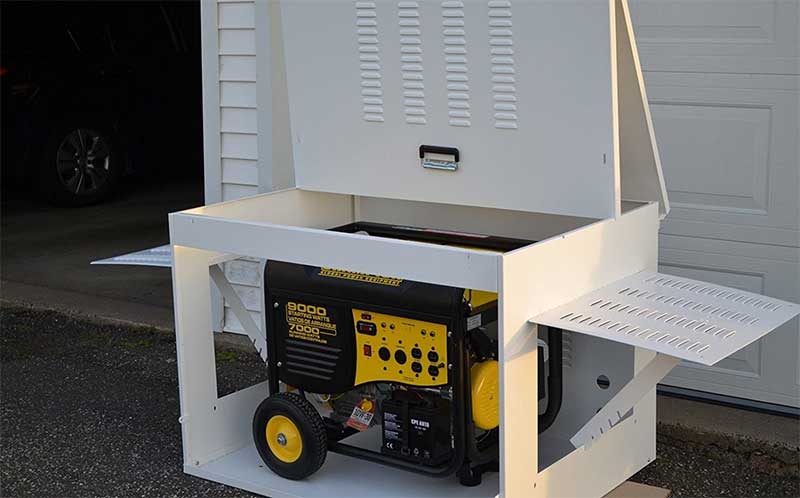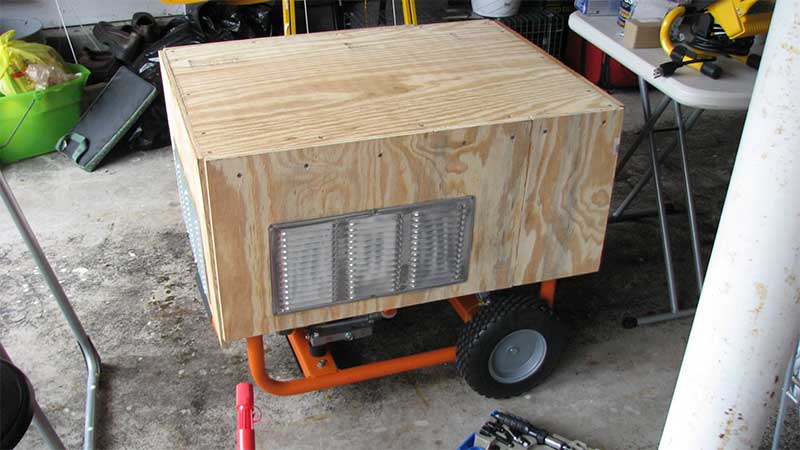Last Updated on May 12, 2023 by Rod Olivares

Natural disasters can cause a lot of problems. When using a portable generator as a backup after a storm, you might run into an additional problem: moisture.
Typically, it’s not safe to use generators in wet weather, rain, or snow.
Often, these conditions are unavoidable and occur when you need the generator’s power most. Is there a solution?
Can you run a generator in the rain?
The short answer is yes, you can run a generator in the rain so long as you have a special cover to shelter it from getting wet. However, you should be extremely careful, and it is still not recommended.
Running a portable gas generator during heavy wind and rain can be deadly
Manufacturers strongly and clearly state that their generators should not be used in rain or other wet conditions, largely because of safety concerns.
Generators produce powerful voltage, and when you add wet conditions, this could lead to electrocution or some kind of explosion.
It could also result in permanent damage to your generator.
If any moisture were to get into the outlets, it could be disastrous.
It’s important to protect your generator from exposure to moisture for safety reasons but also to keep the generator in ideal working condition.
Options for Safely Using a Generator During Wet Conditions
Rain and snow can’t be avoided, but sometimes you still need power during these conditions.
You might be relieved to learn that there are a few options for safely using your generator in wet conditions.
Purchase a special cover

GenTent Safety Canopies are one example of protecting your generator from the elements while safely operating it.
The GenTent canopy protects and waterproofs all of the sensitive areas that you don’t want to get wet.
This special canopy doesn’t interfere with the portability of the generator so you can easily install it and take it down for transport to various locations.
You might think that a cover like this would lead the generator to overheat, but the GenTent canopy maintains quality airflow and promotes natural cooling.

It can handle strong winds up to 70 MPH so you should be safe even in hurricane or blizzard conditions.
The GenTent is a pretty ideal product and is very reasonably priced.
Being able to use your generator safely even in wet and stormy conditions is priceless.
Steel enclosures
Another option is a steel enclosure.
These provide a safe way to operate the generator, but they are quite expensive and generally require professional installation.

You may need to lay a pad of cement to install the enclosure on.
In addition to the possibly prohibitive price, another big downside to a steel enclosure is that it is not portable.
It’s fine to use at home but if you want to move your portable generator, you’ll be stuck without a safe way to power it in wet conditions everywhere else.
You can find similar enclosures made from retrofitted plastic.
These tend to be a bit cheaper than the steel ones but there is a serious concern that the sheds will lead to overheating or possibly even fire.
Build your own enclosure

For the DIY crowd, another option is to build your own enclosure.
You can find a number of tutorials online that will walk you through how to make your own enclosure.
This tutorial teaches you how to make a wooden “doghouse”-style enclosure with venting to prevent overheating.
DIY generator cover
The video above shows you how to make a portable tent that folds up using PVC pipe and tarp.
For this kind of homemade tent, it’s a good idea to place the generator and tent on top of a piece of dry wood when using it in wet conditions.
If you’re in a pinch and don’t have time to build a more permanent enclosure or tent, you may be able to rig up a quick canopy using canvas tarp.
Just make sure that there is no way that moisture can get inside any of the sensitive areas of the generator.
When building your own enclosure to use during wet conditions, it’s important to remember a few things:
- the sensitive areas of the generator, especially the outlets, must be 100% protected from moisture
- you need to maintain some kind of air flow through ventilation or you will risk overheating
- make sure your enclosure can handle the elements, including strong wind
- make sure your enclosure is portable
How do I use a generator safely during a hurricane?
To use your generator during a hurricane, you need a generator cover or rain tent. You must cover your generator from getting wet during a hurricane, tropical storm, or other major rainstorm. Rain can permanently damage a generator and most manufacturers state that they should not be run in the rain.
Champion has a nice generator cover for larger generators, and you can find a nice selection for most generator sizes online.
Never run your gas generator indoors. Often more people die from running gas generators indoors, or improper ventilation of their gas generator, than from the hurricane itself!
Also, consider a non-gas generator option like a battery-powered generator. These newer battery-powered solar generators can now power fridges and TVs for long periods of time due to their ever increasing capacity sizes
Conclusion
Whether you purchase a product like the GenTent Safety Canopy or build your own enclosure, using a generator during wet weather can be a safe and easy experience.
As long as you take the proper precautions, there’s no reason you can’t use your portable generator during a storm.
That’s great news because we often need generators more than ever during storms!
Have you ever used something like the GenTent canopy or a DIY enclosure with your portable generator during rain or snow? How did it go?
If you’ve built your own enclosure, let us know your best tips in the comments.

Scott Krager purchased generatorgrid.com in the summer of 2020 and quickly began to buy every generator under the sun! He currently has over a dozen generators and the number is growing quickly. He lives in Portland, OR near his family and friends.
GeneratorGrid.com is an independent review business. I am not affiliated with any manufacturers and do not accept paid reviews. When you buy through my links, I may earn a commission which helps me purchase more generators for testing. - Scott Krager


This did not answer my question on here… I just purchased the champion dual fuel 3400 watt portable generator..its more in closed than the open big ones..but can it run in the rain because I don’t see a cover for this model at all????????
Hi Mark,
This cover should work fine with your champion generator.
hi Mark, look for the Champion 100603 (just released!) or the GenTent XKU for that sweet Champion dual fuel inverter.
Are you kidding? Did you read the article? It absolutely answers the question. Stop looking to be spoonfed and put on your critical thinking cap and big boy pants.
Just the info I was looking for. Now I’m off to build my generator cover. Thanks for the article.
Really I also face the same situation.
Our office portable generator is placed in our balcony. We did not care because it is a sunny day. But unfortunately rained heavily.
Our offices mates sat without working on that day.
Hence the above method will be useful on certain times and it will provide safety to the people who were handling the generator
Valuable info. You have made me want to now go purchase a generator cover as i have have kept my portable unit out in the open (on rooftop) exposed to rain and moisture.
Thanks a bunch Matt.
I m facing the same problem…
I have made a steel cover for my 2500W generator but its difficult to run it in the rain, also it traps the running heat inside which is also a risk…
Now I’m looking for a safe and easy way to run my generator in all conditions…
I’m happy to see your article which shows that I’m not the only person facing this problem.
I’m applying for my graduate studies in the fields of electrical or mechanical engineering
Insha Allah soon i’ll be an engineer 😉
.
hassan abdal from PAKISTAN
Can a generator be placed in another building and run drop cords out in the rain into my house
how do you refill the gas with the cover on it?
The GenTent refueling door is the panel that the logo is on; it wraps around the adjacent sides.
About 15 years ago built a shelter for a portable generator that sat near our house. We used to have to roll out of shed when needed. Fairly heavy, so built a shed.
Used bolted 2×4’s. Has sloped plywood roof that can be elevated to put gas in top of generator. The sides are open for air and cooling. The frame is light enough two people can lift it off to work on generator. The plywood roof comes off entirely if necessary. The roof slopes so rain runs off the back. When not being used the whole generator is covered with a barbecue grill cover. The only problem is that it is near woods and squirrels get inside cover and store nuts on frame of generator. Guess it is dryer than anywhere else around. Still try not to operate in pouring rain. Usually the worst of storm is over when we need generator. Try to connect power wire before starting so as not handle electric wire when energized. Wire goes outside of shed but heavy rubber. Still would not touch wire when running. Should always turn off generator when doing something with wires. Email phone and I can text picture.
When we lived in Wisconsin for about 10 years, there was a really bad snow storm just a few years ago. To give you an idea of just how bad it was, in one night, there was over 4-5 of snow in the driveway.
The only way we could get the drive way plowed was the county had to send in one of their snow plows with sand in it, to be able to go through that much snow. Then the temperature dropped down to about 0 degrees and the power went out the next day. That left us stranded in the middle of no where with no help from any one.
One of the neighbors out there told us, when we were trying to find some kind of a generator to help us, “We just take care of our own here”, which meant you are on your own and tough luck if you die because you froze to death. Now if you want to know what panic disorder feels like, then just image yourself in that scenario.
You might get a idea of what it is like to suffer from that temperature. Now if the temperature gets below that like 10 degrees below 0 and you have no heat, your in deep trouble and you had better have a plan B backup plan laid out for you ahead of time.
It was a wet snow storm that would freeze right away, so some of the power lines would build up ice and the top line would droop down and touch the lower one and arch, which caused the power to shut down.
It was during that storm that the power went out for about 3 days and of course there was no power. We almost froze to death. Minnesota electricians were called in to give support and fix the problems.
Since then I purchased a 7,500 watt portable generator that can handle just about any of the home electrical power needed.
We also moved back to GOD’s country, Minnesota where the electricians know what they are doing. The portable generator I now have is set up in the garage and is vented through the wall so that the exhaust goes right out side.
I have used it a few times so far and have not had any problems with it. Also, that way, ANY kind of storm that comes, the generator is not affected by it such as 3-4 feet of snow. It has plenty of air and is protected by the garage.
I guess you could say the garage is the oversized shed.
The garage is not attached to the house, so there is no carbon monoxide coming into the house. We ran the appropriate electrical gaged wire from the garage to the house wall.
The wiring that runs from the garage from the generator to the house, is also protected outside by the pvc piping that is underground. The wiring is then fed through the wall into a wall outlet that you can plug 4 different things into if needed. Such as lights and 3- 1500 watt space heaters.
This is a temporary setup until I have an electrician wire in the generator main electrical transfer box to the main electrical panel in the basement. At the moment I am looking at having a standby generator installed that runs on propane, so that if I am ever gone, the electrical part is taken care of.
If you have never had your electricity go out and its in the middle of winter when the temperatures get down to even just 30 degrees, you will find out very fast how cold it can get in your house. You need to have plan B.
unfortunately most all generators i’ve seen don’t have internal GFCI outlets for their main 2-Pole 30A (up to 50A rated) outlets and will require a remote breaker panel with GFCI breaker between your generator shed and your main house breaker panel to protect the cable that runs outside of the generator shed up to the wall of your house. most have the 20A GFCI outlets or you can purchase special in-line GFCI cables rated up to 20A. just an FYI for people trying to do this with larger generators. This still dosen’t protect you between your generator and GFCI remote breaker panel though so you need to locate those 2 as close as possible in a dry shed. This will also require you to sink another ground rod next to your generator to ground the remote breaker panel and shed (if its metal). I’m not an expert, and there may be loop-holes to get around this, but this is the safest and most code-friendly way to do it.
Is there a concern during a lighting storm? Using a generator during a lighting storm that is. Thanks for your assistance.
While the risk is very small of having a direct lighting strike, it never hurts to have your generator and entire electrical system properly grounded, this will reduce the odds of your house burning down from a direct strike, but it more then likely won’t save the generator or anything plugged in, even a properly designed and engineered system will have limits, beyond this there is insurance.
It’s all in the odds which are about 1 in 700,000, you could be struck by lighting in a year and die accroding to Nat Geo, but I don’t think the odds are that high when compaired to other things that can happen in the dark that can cause serious injury or death like walking around a dark house and tripping or falling, or causing a fire from using candles, or eatting spoiled food.
The odds are also lower of you having a damaging surge coming from the grid if you are disconnected from it by a proper transfer switch and running on a generator. Personally I will fire up the generator if needed not worried about lighting strikes, it’s better then falling down the stairs in the dark.
Hello, does anyone know of a cover/small shed big enough for a Honda/Recoil Gasoline Portable Inverter Generator #EU7000iAT1? I would like to store it outside, and keep it covered and protected from elements but also figure out a way to safely run in it in a storm if necessary. I am planning to keep it on a large back deck that is 3 feet above ground level. I can put generator 10-15 feet from house, and run extension cord the 15 feet to the connection to my house. I am concerned about flooding from storms if I keep the generator on a concrete base at actual ground level. I do not have a garage.
if you have a wood picnic table and a few cargo staps you don’t have to leave the generator on the concrete slab, they will run on a good picnic table like one made from 2×6 lumber, strap them down so they don’t vibrate off. And make sure you get someone to help you lift it those units are about 250 plus pounds. If you tie a patio umbrella to it, the umbrella shouldn’t take flight in the wind or gusts.
How about using a resin deck box or smaller resin type storage shed?
i made a cover using two pieces of !/4 “ plywood, each 2’ x 4’. i attached the pieces to a 1”x1” frame the length of the gen set. i connected the two pieces of plywood at the top of the frame and ran a 1”x1” piece across the bottom to complete the structure. i attached two “u” shaped tool hangers on each cross piece that allowed the entire structure to sit on the gen set frame, end pieces. i can prop one end up to start and re-fuel and the structure is gabled to allow good ventilation and rain and snow to slide off. my gen sheet is not 4’ long thus there is about a 6” overhang on each end and the top pieces hang down over the gen set enough to protect the connections. painted the entire structure for additional protection and works great. would be glad to email pics if someone provides an email.
Maine snowstorms leave us with over a foot or two of snow. How much protection and what’s the best type of protection for my new, portable generator? Thanks.
I’d go with a hardcover generator tent like this one.